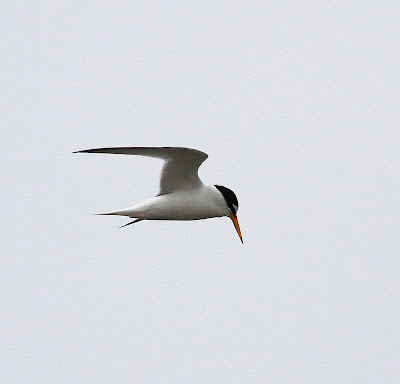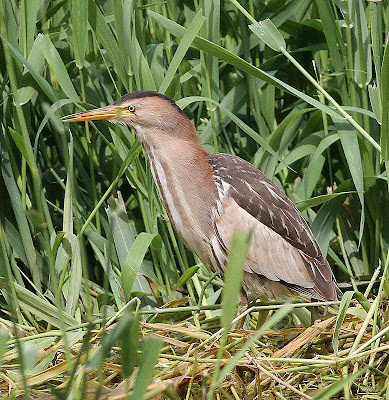One of the joys of fishing is that you have to concentrate, have fast reactions and, best of all, never know what you are going to catch (I am obviously not talking about Carp fishing here). One of my objectives whilst on holiday in Norfolk was to photograph Little Terns in flight, which bears remarkable similarities to fishing. Concentration to get the approaching birds tee-ed up, fast reactions to get the fast-moving subject in the viewer and focussed and, at least while you are snapping away, not knowing whether you have caught any good action shots.
I set myself up next to the sea on Cley beach and waited for the first Little
Tern to appear. The problem here is that you can wait for long periods
of time with nothing happening and get distracted watching something else when
three shoot past without the camera even being raised. However, after a
bit of practice, I did get the hang of it, although I did have to take
about 600 shots to salvage a few reasonable snaps.
Sunday 24 June 2012
Thursday 21 June 2012
Avocets in Action
Don't you just love Avocets? When I was a boy Avocets were extremely rare and the only breeding site in the UK was at Havergate Island, bought by the RSPB in 1948. The warden was Reg Partridge. Now they are common breeders around our coast almost to the detriment of our other breeding waders as they are very aggressive and territorial. I remember reading an entry by Mark Golley in the Cley log in Arkwright's Cafe about 20 years ago, bemoaning the fact that there were not many birds around, which simply said "the Avocet mono-culture has taken over".
We were spending a few days at Blakeney and called in at Cley and Salthouse to see what was about. At Salthouse there was an Avocet asleep in a pool next to a footpath. I was wondering how close I might get when I noticed a couple walking along the footpath, passing within 10 yards of the bird without it even waking up. So with camera in hand I proceeded along the footpath. I managed to get within about 10 yards when the bird woke up and started to feed, sometimes coming even closer.
As I edged my way along the path following the Avocet as it fed there was a strident "peep,peep,peep" just yards to my left. I looked down and there, almost at my feet, was an Avocet sitting on her nest just inches from the path. She did not leave the nest but was just warning me of her presence.
Meanwhile at Cley there were lots of Avocet chicks running round. I have never quite understood how they manage to survive when there are so many Marsh Harriers floating around.
And who could resist a couple of flight shots of these superb birds?
We were spending a few days at Blakeney and called in at Cley and Salthouse to see what was about. At Salthouse there was an Avocet asleep in a pool next to a footpath. I was wondering how close I might get when I noticed a couple walking along the footpath, passing within 10 yards of the bird without it even waking up. So with camera in hand I proceeded along the footpath. I managed to get within about 10 yards when the bird woke up and started to feed, sometimes coming even closer.
As I edged my way along the path following the Avocet as it fed there was a strident "peep,peep,peep" just yards to my left. I looked down and there, almost at my feet, was an Avocet sitting on her nest just inches from the path. She did not leave the nest but was just warning me of her presence.
Meanwhile at Cley there were lots of Avocet chicks running round. I have never quite understood how they manage to survive when there are so many Marsh Harriers floating around.
And who could resist a couple of flight shots of these superb birds?
Sunday 17 June 2012
A Day Out at Salthouse and Cley
When spending a week at Blakeney a day out to Salthouse and Cley is compulsory. I had chosen Salthouse first as there had been a Spoonbill reported there the day before but that would have appeared to have departed. There were a couple of Avocets on a pool by the footpath (more of that later) but what caught my eye was a 1st summer Black-headed Gull sitting on a fence post. The attraction here was that there was a field in the distance, which would be totally out of focus in the photo and therefore provide a nice dark green backcloth for the subject.
We now moved on to the Cley and started walking out to the group of three hides in the middle of the reserve. On the way a male Reed Bunting was singing from an Elder and seemed totally unperturbed by our presence.
At the hides the reserve was fairly quiet as the Avocets had taken over most areas. However in front of one of the hides a lone Redshank was frantically feeding at close range allowing some good close-up shots.
In the distance there were no fewer than four Spoonbills, all with their heads tucked in fast asleep. They were too distant for a reasonable shot but after a couple of hours they decided to take off for a fly round providing a couple of opportunities. Not having seen many Spoonbills, I had never realised that their primaries were black-tipped.
Finally, to end off the day, we went to the beach to see if there were any terns feeding along the shoreline (more of that later). As we got out of the car it was clear that there were a number of swallows around the red pan-tiled shelter there. A number of wooden slats had been positioned inside the shelter to provide nesting sites and a number of these were in use. Eventually the sun came out and a couple of adults took the opportunity to have a break from nesting duties and have a bask in the sun. Note the use of a distant green field as a backcloth again.
We now moved on to the Cley and started walking out to the group of three hides in the middle of the reserve. On the way a male Reed Bunting was singing from an Elder and seemed totally unperturbed by our presence.
At the hides the reserve was fairly quiet as the Avocets had taken over most areas. However in front of one of the hides a lone Redshank was frantically feeding at close range allowing some good close-up shots.
In the distance there were no fewer than four Spoonbills, all with their heads tucked in fast asleep. They were too distant for a reasonable shot but after a couple of hours they decided to take off for a fly round providing a couple of opportunities. Not having seen many Spoonbills, I had never realised that their primaries were black-tipped.
Finally, to end off the day, we went to the beach to see if there were any terns feeding along the shoreline (more of that later). As we got out of the car it was clear that there were a number of swallows around the red pan-tiled shelter there. A number of wooden slats had been positioned inside the shelter to provide nesting sites and a number of these were in use. Eventually the sun came out and a couple of adults took the opportunity to have a break from nesting duties and have a bask in the sun. Note the use of a distant green field as a backcloth again.
Thursday 14 June 2012
Little Bittern at Stocker's Lake
What an amazing story. A non-birder was walking along the River Colne at Stocker's Lake and saw a small water bird on the opposite bank. He didn't recognise the bird so took a photograph and sent it in to the Herts Bird Club. The bird turned out to be a Little Bittern, only the 5th for the county since 1900.
A number of birders rushed down to the area and searched until dusk but the bird could not be re-found. Then on the following day, June 13th, Steve Blake located the bird and sent the news out. I received a phone call from Joan Thompson and, when I had completed the survey work that I was carrying out, zoomed over to Stocker's and joined the gathering throng.
The bird was deep in cover and all you could see was a smudge of brown as it moved slowly through the reeds. Eventually the bird was flushed by some Grey Lag Geese and flew downstream. It was quickly re-located, this time in the open, and allowed a number of shots to be taken.
A number of birders rushed down to the area and searched until dusk but the bird could not be re-found. Then on the following day, June 13th, Steve Blake located the bird and sent the news out. I received a phone call from Joan Thompson and, when I had completed the survey work that I was carrying out, zoomed over to Stocker's and joined the gathering throng.
The bird was deep in cover and all you could see was a smudge of brown as it moved slowly through the reeds. Eventually the bird was flushed by some Grey Lag Geese and flew downstream. It was quickly re-located, this time in the open, and allowed a number of shots to be taken.
Wednesday 13 June 2012
A Pitstop at Titchwell
When you are on your way for a week at Blakeney what better place to stop for a break than Titchwell? As it was now late May the reserve was relatively quiet with the emphasis on breeding. On our way along the path to the first hide a Sedge Warbler was uttering its scratchy song in a reed bed and occasionally broke cover to ascend for a song flight.
Further along on the saline lagoons was a now common Little Egret ,strutting its stuff in one of the pools. Like so many other posers, although you have an album full of photos, it is not possible to walk past without taking a few more shots, particularly when they are in still water throwing a reflection. And who can resist those yellow feet?
Not surprisingly the beach was very quiet with just a handful of Oystercatchers and Curlew. Ostercatchers in flight also fall into the "must photograph" category as they usually pass fairly close and their black and white plumage and red bills show up well against a blue sky.
But the pride of place on the beach must go to the one or two Sanderlings that were in transitional summer plumage. Unfortunately, unlike their winter-plumaged counterparts, they were nowhere near as approachable but did allow a few record shots.
Further along on the saline lagoons was a now common Little Egret ,strutting its stuff in one of the pools. Like so many other posers, although you have an album full of photos, it is not possible to walk past without taking a few more shots, particularly when they are in still water throwing a reflection. And who can resist those yellow feet?
Not surprisingly the beach was very quiet with just a handful of Oystercatchers and Curlew. Ostercatchers in flight also fall into the "must photograph" category as they usually pass fairly close and their black and white plumage and red bills show up well against a blue sky.
But the pride of place on the beach must go to the one or two Sanderlings that were in transitional summer plumage. Unfortunately, unlike their winter-plumaged counterparts, they were nowhere near as approachable but did allow a few record shots.
Subscribe to:
Posts (Atom)

















































